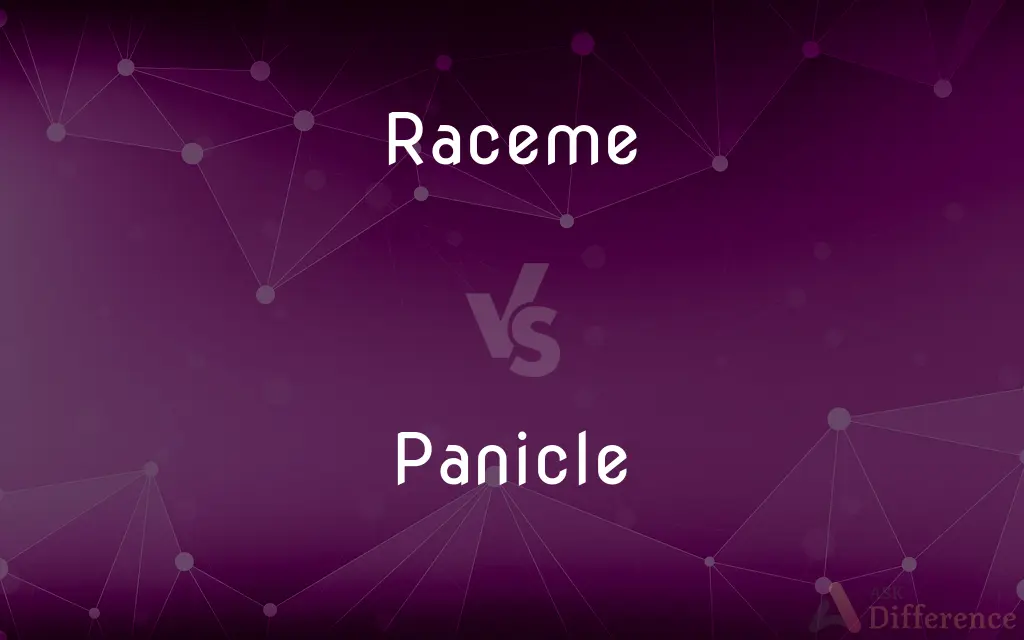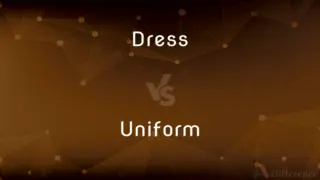Raceme vs. Panicle — What's the Difference?
Edited by Tayyaba Rehman — By Maham Liaqat — Updated on March 15, 2024
A raceme is a simple, unbranched flower cluster with pedicelled flowers, whereas a panicle features a complex, branched structure.

Difference Between Raceme and Panicle
Table of Contents
ADVERTISEMENT
Key Differences
A raceme is a type of inflorescence characterized by a central stem or axis, along which multiple flowers are arranged at equal intervals, each attached by its own short stalk, known as a pedicel. In contrast, a panicle is a more complex form of inflorescence that is branched, featuring a main axis that subdivides into multiple branches, each of which may further branch out or bear flowers directly. This
The raceme's unbranched nature makes it relatively straightforward and easy to identify, with a visually coherent line of flowers or buds extending from the main stem. This simplicity is visually distinct from the more intricate and often bushier appearance of a panicle, which can add visual complexity and depth to the plant's overall appearance.
Racemes are commonly found in plants such as certain species of peas, lupins, and the mustard family, where the clear, linear arrangement aids in identification and study. Panicles, however, are typical of many grasses, including economically important grains like rice, wheat, and oats, as well as ornamental plants, where their branching patterns contribute to the plant's aesthetic and structural diversity.
The primary difference in functionality between racemes and panicles may relate to pollination strategies and seed dispersal mechanisms. The raceme's orderly arrangement can facilitate access for specific pollinators, while the panicle's complex structure might appeal to a broader range of pollinators or aid in wind dispersal of pollen or seeds, depending on the plant species.
Comparison Chart
Structure
Unbranched, linear
Branched, complex
ADVERTISEMENT
Flower Arrangement
Evenly spaced along a central stem
Branches with flowers or further subdivisions
Common Examples
Peas, lupins, mustards
Rice, wheat, oats, ornamentals
Blooming Pattern
Sequential, from bottom upwards
Varied, depending on branch development
Pollination Strategy
May facilitate specific pollinators
Can appeal to a broader range or aid in wind dispersal
Compare with Definitions
Raceme
A simple, linear flower cluster with each flower on its own short stalk.
The delicate raceme of the wisteria emits a fragrant aroma.
Panicle
A complex, branched flower cluster with multiple levels of subdivision.
The rice plant's panicle is crucial for grain production.
Raceme
Characterized by unbranched, evenly spaced flowers.
The raceme of the lupin adds vertical interest to the garden.
Panicle
Adaptable for wind pollination or attracting diverse pollinators.
The ornamental grasses' panicles sway beautifully, dispersing pollen.
Raceme
Flowers bloom sequentially from bottom to top.
The cherry blossom's raceme ensures a prolonged display of flowers.
Panicle
Features a main axis with branching stems bearing flowers.
The panicle of the oat plant varies in density and shape.
Raceme
Defined by its simplicity and elegance.
The raceme structure of the foxglove adds to its charm.
Panicle
Adds visual complexity and depth to plant design.
The hydrangea's panicle is a focal point in late summer gardens.
Raceme
Suited for plants with a focus on specific pollinators.
The bee-friendly raceme of the borage plant is a pollinator magnet.
Panicle
Can have varied blooming patterns due to branching.
The astilbe's panicle offers a feathery texture to garden designs.
Raceme
A raceme ( or ) or racemoid is an unbranched, indeterminate type of inflorescence bearing pedicellate flowers (flowers having short floral stalks called pedicels) along its axis. In botany, an axis means a shoot, in this case one bearing the flowers.
Panicle
A panicle is a much-branched inflorescence. Some authors distinguish it from a compound spike inflorescence, by requiring that the flowers (and fruit) be pedicellate (having a single stem per flower).
Raceme
An inflorescence having stalked flowers arranged singly along an elongated unbranched axis, with the flowers at the bottom opening first.
Panicle
A loosely branched inflorescence, especially a branching raceme.
Raceme
(botany) An indeterminate inflorescence in which the flowers are arranged along a single central axis.
Panicle
(botany) A compound raceme.
Raceme
A flower cluster with an elongated axis and many one-flowered lateral pedicels, as in the currant and chokecherry.
Panicle
A pyramidal form of inflorescence, in which the cluster is loosely branched below and gradually simpler toward the end.
Raceme
Usually elongate cluster of flowers along the main stem in which the flowers at the base open first
Panicle
Compound raceme or branched cluster of flowers
Common Curiosities
Why are racemes and panicles important in botany?
They help in the identification of plants and understanding their reproductive strategies, pollination mechanisms, and evolutionary adaptations.
How does the structure of a raceme or panicle affect pollination?
The structure can influence the accessibility for pollinators, with racemes potentially targeting specific pollinators and panicles appealing to a broader range or facilitating wind pollination.
What distinguishes a panicle from a raceme?
A panicle is distinguished by its complex, branched structure, in contrast to the simple, unbranched arrangement of a raceme.
Are racemes always vertical?
While typically vertical, racemes can also be horizontal or drooping, depending on the plant species.
Can the structure of a panicle vary between species?
Yes, panicles can vary widely in size, shape, and complexity, reflecting the diverse ecological niches and pollination strategies of different species.
Do racemes or panicles require specific environmental conditions to develop?
While environmental conditions can influence the development and appearance of these inflorescences, the primary determinant is genetic, with each plant species adapted to its typical habitat.
Can racemes and panicles be found on the same plant?
While less common, some plants may feature both racemes and panicles at different stages of growth or in different parts of the plant.
Is there a relationship between the flowering pattern of racemes and panicles and seed dispersal?
Yes, the sequential blooming of racemes and the structural diversity of panicles can both affect how seeds are dispersed, either by attracting specific pollinators or through mechanisms like wind dispersal.
What is a raceme?
A raceme is a simple, elongated flower cluster with each flower attached to the main axis by its own short stalk.
How do gardeners use knowledge of racemes and panicles?
Gardeners use this knowledge to select plants that will provide the desired visual effect, pollination benefits, or adaptability to specific garden conditions.
Share Your Discovery

Previous Comparison
Dress vs. Uniform
Next Comparison
Maximize vs. MaximalizeAuthor Spotlight
Written by
Maham LiaqatEdited by
Tayyaba RehmanTayyaba Rehman is a distinguished writer, currently serving as a primary contributor to askdifference.com. As a researcher in semantics and etymology, Tayyaba's passion for the complexity of languages and their distinctions has found a perfect home on the platform. Tayyaba delves into the intricacies of language, distinguishing between commonly confused words and phrases, thereby providing clarity for readers worldwide.














































